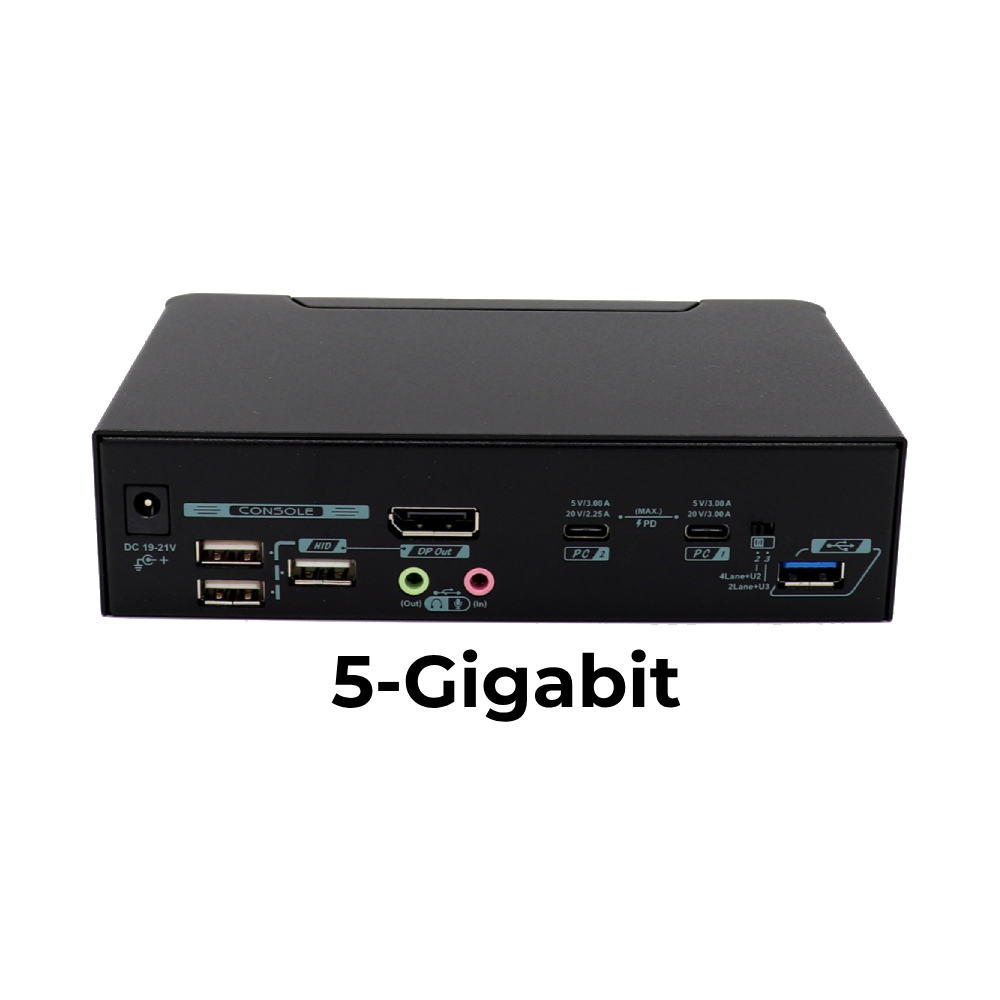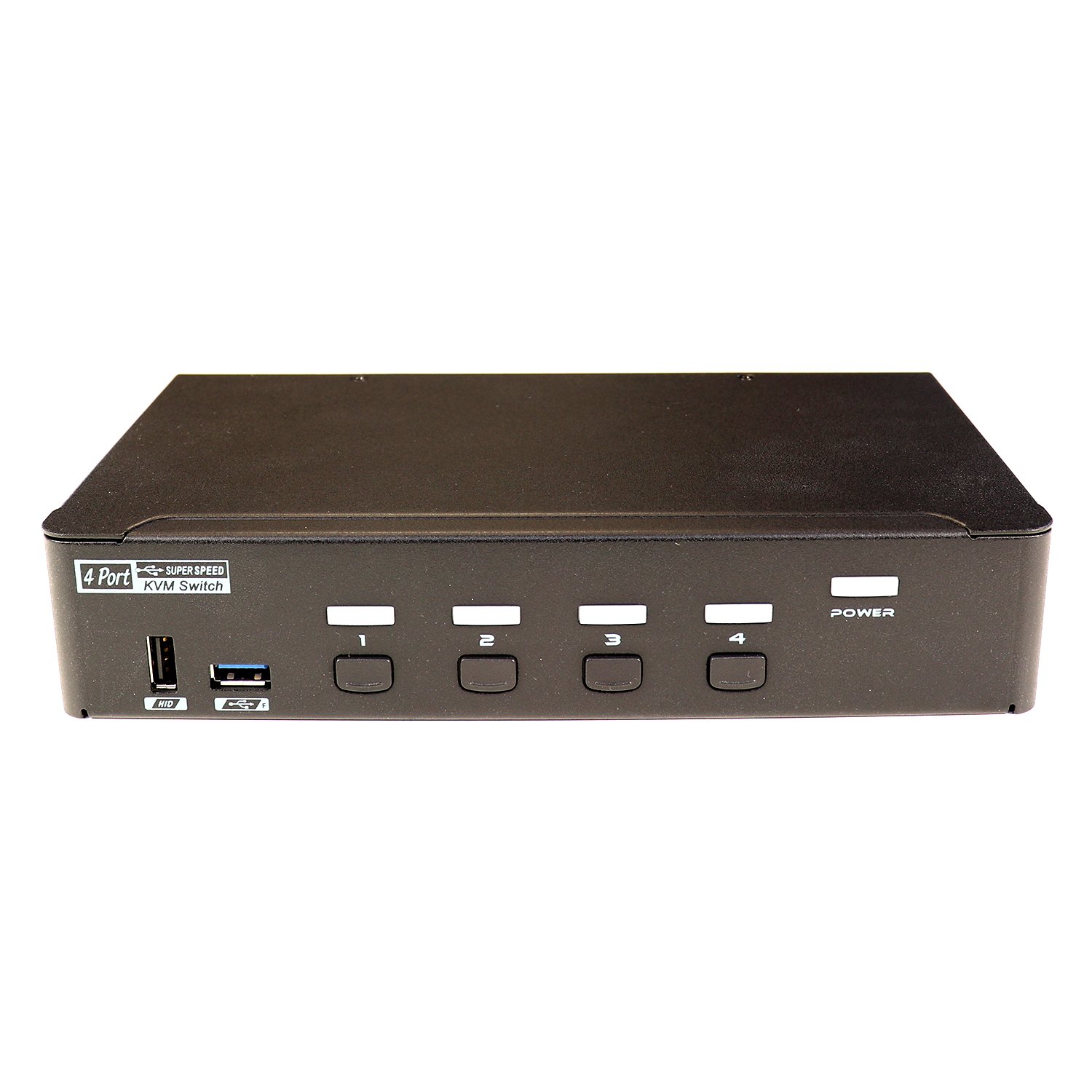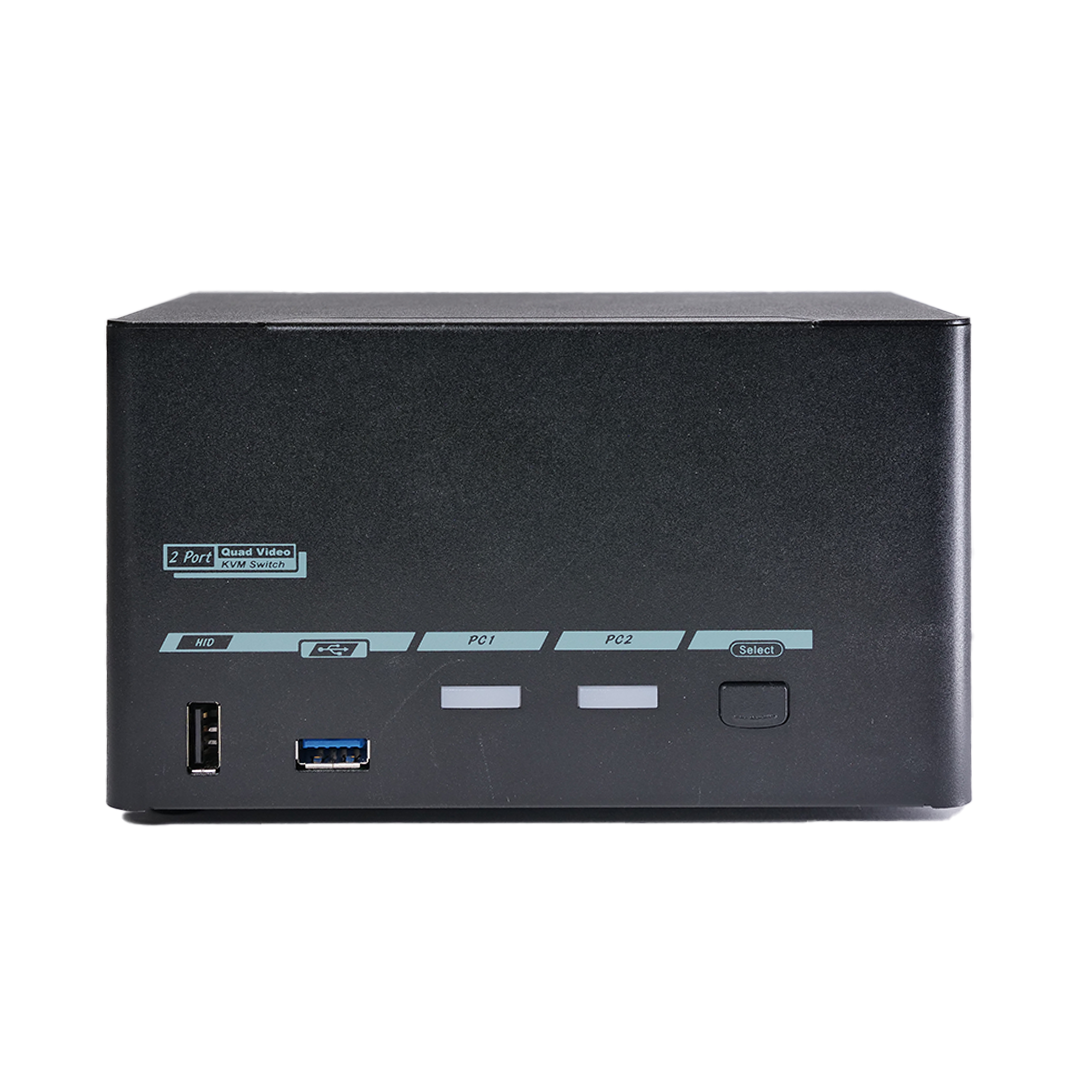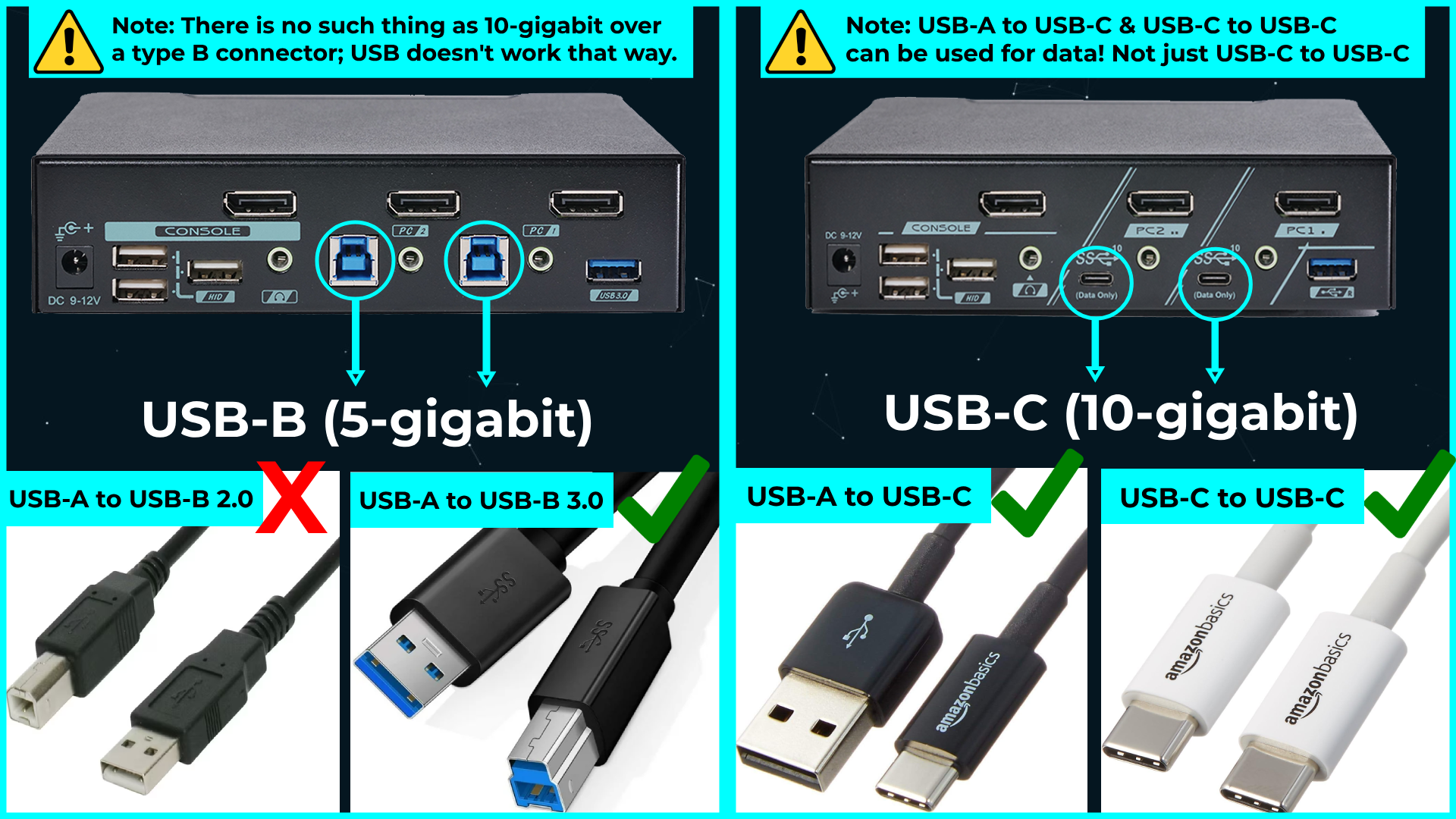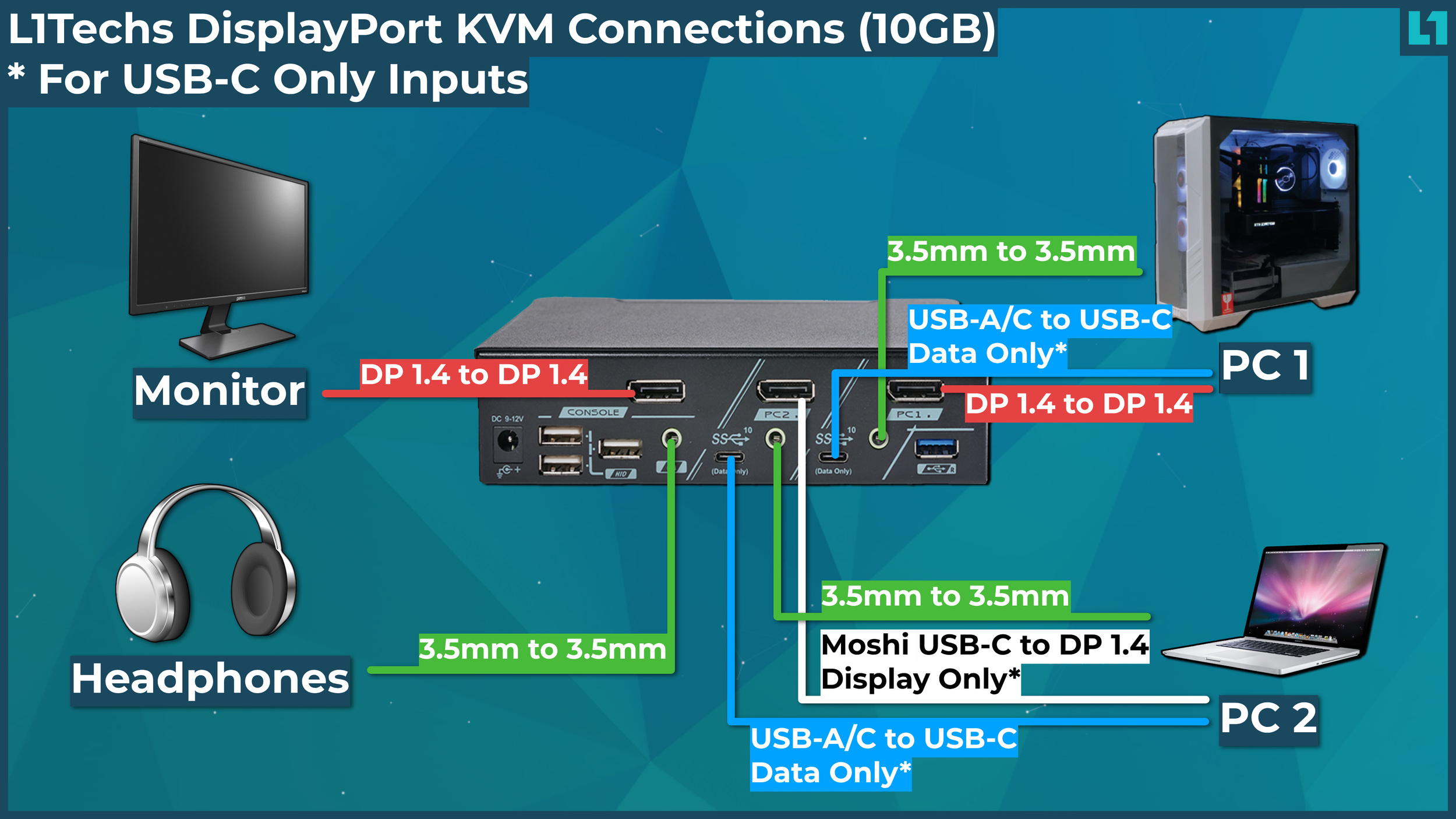This KVM switch will let you use ONE(1) DisplayPort monitor plus other USB peripherals between up to two(2) USB-C devices such as a laptop and an iPad, two(2) laptops, or a laptop and a desktop.
Inputs:
1 USB-C input from each of two computers (USB + DisplayPort signal on one wire)
Outputs:
Display Port 1.4* (see additional notes, limitations apply)
4x USB HID
2x USB 3.1 gen 1 5gbps
3.5mm Audio Microphone
3.5mm Audio Headphone
Controls:
USB Mode: 5gbps USB3 (uses 25% of DisplayPort bandwidth)
USB2 mode (prioritize DisplayPort bandwidth)
Power Mode: Control how many amps to which USB-C Port
How our KVMs are different:
Most KVM switches are meant to work with servers, and basic mice and keyboards.
Our KVMs:
This KVM switch will work with USB 3.0 (USB 3 5gbps, or USB 3.2 gen 1) peripherals as well as USB 2.0 HID devices.
It has also been tested to work with high-end RGB gaming keyboards like keyboards from Corsair*, Cougar and more.
It has been tested with keyboards that have built-in USB hubs as well as USB pass-through.
It is possible to feed the output of this KVM into another Level1Techs KVM so that you can have “native” USB devices on your KVM.
*See the ‘Additional Info’ section for extra details regarding the use of Corsair keyboards.
It has also been tested to be compatible with Samsung DeX (while using a similarly compatible monitor).
The included power brick is auto-sensing 100-240 volts, 135 watts output, 19.5 volts DC, center positive. The box includes a US-style power cord, but any "local" NEMA 5-15P power cord (computer power cord) can be used for your region, nothing special is required.
Wendell uses it with an IBM Model M modified to use QMK firmware, with n-key rollover disabled, and it works great.
KVM Rack Mount Kit not included
For technical support or questions regarding KVMs and their accessories that are not answered in the product description or additional info section, please submit a support ticket.
Important Usage Information
The KVM uses USB and DP input on the same USB-C connector. It is not Thunderbolt, but often Thunderbolt ports can fallback to USB + DP on one USB-C connection. Sharing USB and DisplayPort on the same USB-C cabling will limit the total bandwidth of the cable.
Unfortunately, it is not possible to support the full DP 1.4 bandwidth AND USB 5gbps speeds with just one wire. So, we give you the option. At the back of the KVM is a switch that lets you pick between USB3 and USB2 speeds. This switch prioritizes DisplayPort bandwidth or USB bandwidth, in other words.
While we don’t recommend USB switching with mass storage devices, it is possible. It will also let you share peripherals like scanners and printers through USB (note: Maximum 1A power through USB connections).
We do not recommend this KVM for resolutions and refresh rates beyond 5k/75hz. It is possible to run lower resolutions with higher refresh rates -- 120hz @ 1440p has been well-tested, as well as 4k @ 90hz from a desktop gaming computer.
The KVM will not work with *just* a USB-C USB connection. The device you are connecting to the KVM via USB-C must be from a USB-C port that does USB+DisplayPort such as on the RTX 2080Ti, some Radeon 6800 series GPUs and desktops that have a DisplayPort input for Thunderbolt passthrough.
In addition we recommend you use short (less than 4 meters), high quality USB-C cables that are rated for both USB-C and DisplayPort signals.
Corsair keyboards are currently unable to use KVM or KM hotkeys when plugged into HID ports.*
Why Our KVM Switches Don’t Include an Ethernet Port
We often get asked why our KVM (Keyboard, Video, Mouse) switches don’t come with an Ethernet port. It’s a great question — and the answer has everything to do with keeping your network stable and your devices protected.
Our KVM switches are designed to cleanly switch control of your keyboard, video, and mouse — but networking is a different story. If we were to add an Ethernet port and try to switch it between devices, we’d essentially be reinventing something that already exists: a network switch.
Network switches are made to manage multiple devices on a shared network reliably and simultaneously. They handle traffic differently and are designed for constant connectivity — not for quick, manual switching like a KVM. Combining these two roles could lead to unnecessary complexity and reliability issues.
In short, we believe in using the right tool for the job. That’s why we leave networking to the dedicated Ethernet switches — and focus on building rock-solid KVMs that do their job well.
**Monitor Emulation**
> This KVM does not support monitor emulation <
Monitor emulation makes sure the input has an exact copy of the display's EDID (Extended Display Identification Data) even when disconnected. Being that this KVM does not have monitor emulation, when switching between desktops, your monitor and KVM will re-handshake. AKA the windows will shuffle unless you have a software or hardware solution.
For your convenience, here are some compatible options that we know of with this KVM:
**Windows**
Windows 11 - Settings > System > Display > Multiple Displays (drop down) and check the option labelled "Remember windows locations based on monitor connection" and uncheck "Minimize windows when a monitor is disconnected"
Windows 10 - Persistent Windows https://github.com/kangyu-california/PersistentWindows
**macOS**
macOS Ventura (and newer) - System Settings > Desktop \& Dock > Mission Control and uncheck the box next to "Automatically rearrange Spaces based on most recent use"
macOS Monterey (and older) - System Preferences > Mission Control and uncheck the box next to "Automatically rearrange Spaces based on most recent use"
You can also use the terminal to change the setting.
To disable rearrangement:
defaults write com.apple.dock "mru-spaces" -bool "false" \&\& killall Dock"
credit: https://apple.stackexchange.com/questions/214348/how-to-prevent-mac-from-changing-the-order-of-desktops-spaces


